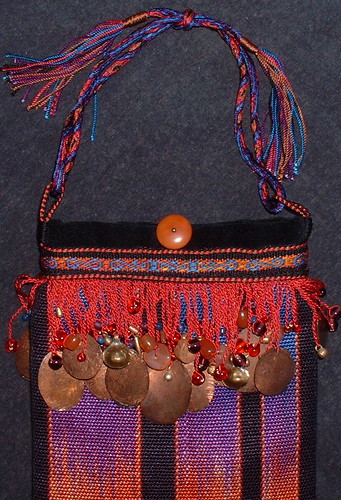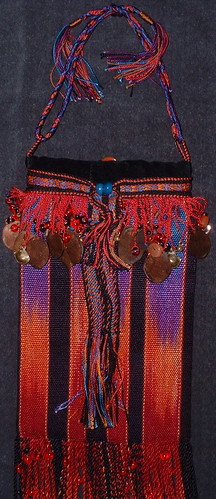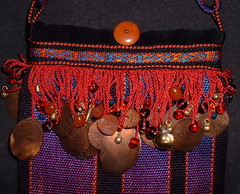In The Beginning
there was a left over piece of silk fabric too good to throw away. It's Henry's Attic Cascade silk, sett at 36 epi, woven with 5/2 cotton. The project was a scarf, this is the remnant:

It became the first bag, and began a series which lasted for a full 5 years, and morphed into knotted pile.
This first bag took months to complete, not because it was so difficult, but because I was inventing solutions as I worked. I folded the fabric, and butted the selvedges together for a back seam. Then I twisted the fringe (the thrums) to close the bottom, adding beads as I twisted. Thus the bottom edge was weak (yep, no sewing), and required lining the reinforce it. Then I had to figure out a way to complete the top (raw) edge. I tried black leather first, not so good. Then I tried black velvet, and it was good.

The embellishments started with a band to trim that velvet edge. I took a class from Ed Franquemont at SOAR 1994 (Oregon) to learn Peruvian pickup (the "S") band, and the Nawi Awapi (the handle), which is normally used as an edge treatment, but is here freestanding. I used Gudebrod silk for these bands, and the Kumihimo, which trims either side of the "S" band. The Kumihimo was another of those "what next" moments in construction: it attaches the handle.
The coins and beads were added with twisted silk, but first I had to smash the coins. This was before the Penny Smasher, and yes, it involves railroad tracks, too much wine and fear of authority. But that is a story for another day.
This is a well traveled bag, it's been in shows all over the country, used in advertisements and has appeared in print. Backwards.

Yep. And I had so thought the very front to be the most, best, wondrous weaving:

if you look closely (or click on it for a big version), you'll see the "S" colors switch: I went from dark "S" on light ground, to light "S" on dark ground, right at the center. Too subtle to notice? Yeah, well, that's what everyone else says too. It probably did not help that both warps for the band are painted, which further obscures the fabulous (and so modestly said) weaving. So the nifty and mind boggling, impressive special effects go unrecognized. Harumph. Guess they aren't so nifty after all.

It became the first bag, and began a series which lasted for a full 5 years, and morphed into knotted pile.
This first bag took months to complete, not because it was so difficult, but because I was inventing solutions as I worked. I folded the fabric, and butted the selvedges together for a back seam. Then I twisted the fringe (the thrums) to close the bottom, adding beads as I twisted. Thus the bottom edge was weak (yep, no sewing), and required lining the reinforce it. Then I had to figure out a way to complete the top (raw) edge. I tried black leather first, not so good. Then I tried black velvet, and it was good.

The embellishments started with a band to trim that velvet edge. I took a class from Ed Franquemont at SOAR 1994 (Oregon) to learn Peruvian pickup (the "S") band, and the Nawi Awapi (the handle), which is normally used as an edge treatment, but is here freestanding. I used Gudebrod silk for these bands, and the Kumihimo, which trims either side of the "S" band. The Kumihimo was another of those "what next" moments in construction: it attaches the handle.
The coins and beads were added with twisted silk, but first I had to smash the coins. This was before the Penny Smasher, and yes, it involves railroad tracks, too much wine and fear of authority. But that is a story for another day.
This is a well traveled bag, it's been in shows all over the country, used in advertisements and has appeared in print. Backwards.

Yep. And I had so thought the very front to be the most, best, wondrous weaving:

if you look closely (or click on it for a big version), you'll see the "S" colors switch: I went from dark "S" on light ground, to light "S" on dark ground, right at the center. Too subtle to notice? Yeah, well, that's what everyone else says too. It probably did not help that both warps for the band are painted, which further obscures the fabulous (and so modestly said) weaving. So the nifty and mind boggling, impressive special effects go unrecognized. Harumph. Guess they aren't so nifty after all.

4 Comments:
No,they're still nifty; and even if they don't smack you in the eye right off, they still add something irreplaceable to the whole.
lisa
www.blackwaterpark.blogs.com
I'll admit that I've got no freakin' idea what you are talking about.
But I can admire the pretty bag regardless.
I loved seeing the S-es when you pointed them out. It was helpful to me to have a verbal "tour of the artwork" and it made me slow down and appreciate all that went into that bag - THANKS! This entry was lovely.
Bought a little coin purse this weekend down on the central coast made from leftover pieces of handwoven and lots of beads and then came home to your post. How serendipitous and how much more lovely is yours! And having two exemplars is even more inspiring than just one.
Post a Comment
<< Home